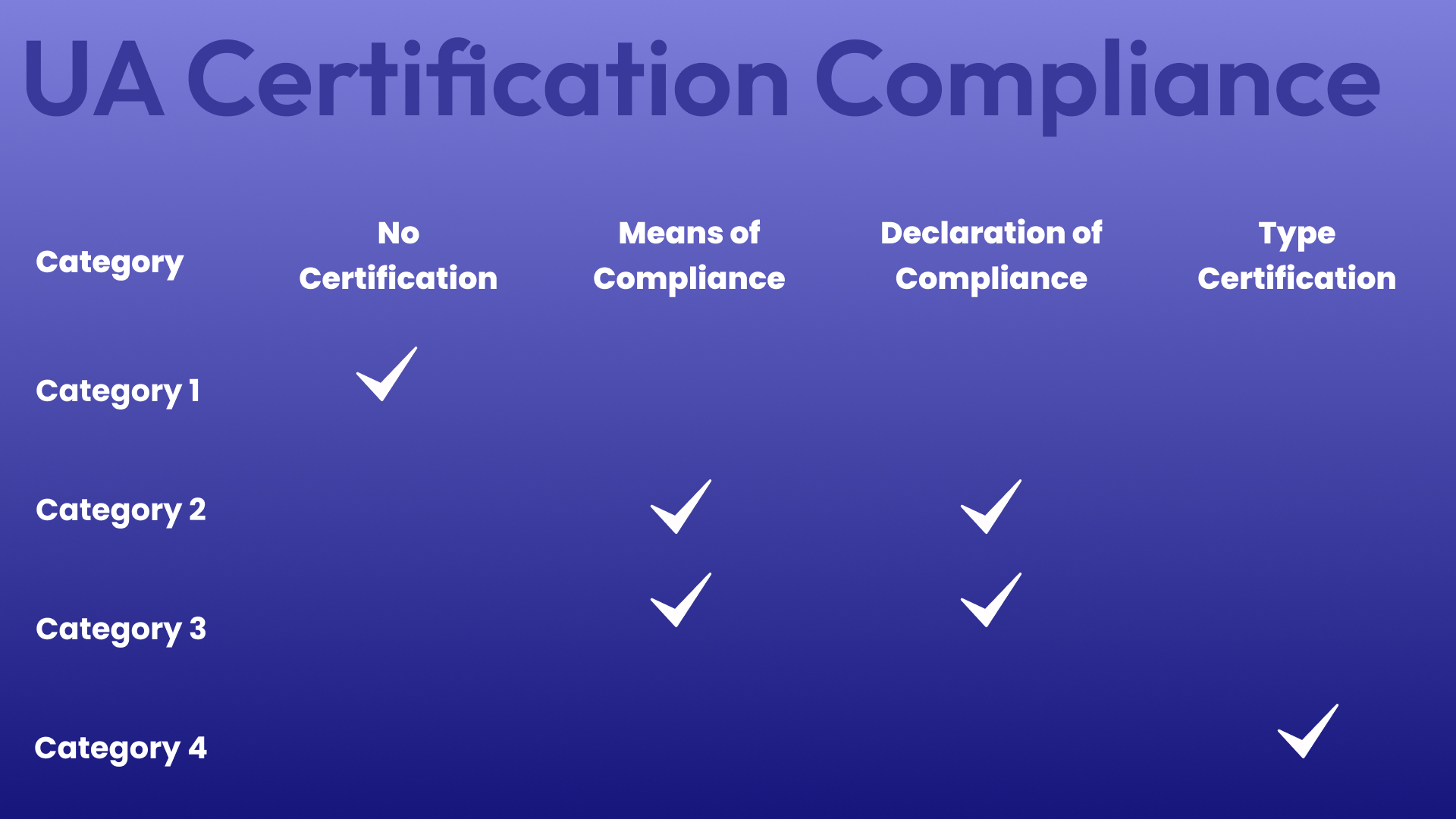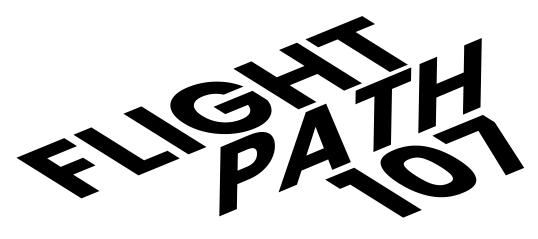Introducing Drone Categories 1-4
Lesson Section Tagline intro if Applicable. Remove if nothing there.
When it comes to flying unmanned aircraft (UAs), the rules aren’t one-size-fits-all.
Drones are classified into categories based on various factors, such as their weight, potential risk in the event of a crash, and any hazardous parts like spinning blades.
These categories—1, 2, 3, or 4—help set clear guidelines for where, when, and how you can fly, depending on the level of risk involved.
Your UA category will be determined by, and will influence what is permitted in relation to the following operational factors:
Weight of UA: The total mass of the drone, including all components and payload, measured before flight.
Kinetic Energy of UA: The energy the drone has while moving, determined by its mass and speed, critical for assessing impact risks.
Flight Over Bystanders: Operations where a drone flies directly over people not involved in the flight activity.
Flight Over Open-Air Assembly: Drone flights above large gatherings of people in open spaces, like stadiums or concerts.
Flight Mandating Restricted Access Area: Flights requiring a secured area to keep unauthorized people out for safety reasons.
Flight in Transit vs Hovering: The distinction between a drone moving from one location to another (flight in transit) versus remaining in a fixed position (hovering) during operation.
Certification of Compliance: Verification that the drone meets FAA safety and design standards for its intended category of operation.
Lesson Prep
In this lesson, we’ll break down what each of these categories means, explaining the specific conditions and regulations tied to them. Then, we’ll look at the requirements and restrictions that come with each category, so you can understand what’s allowed and what’s not based on the category classification of your unmanned aircraft (UA).
Introducing UAS
Categories 1,2,3,4
Categories
Category 1:
Low-risk operations, typically involving small drones with minimal risk to people and property.
Category 2:
Slightly higher risk operations, usually requiring more safety measures and certifications.
Category 3:
Higher-risk operations, often involving larger drones or more complex missions with strict operational and safety requirements.
Category 4:
High-risk operations, usually involving large drones or those used in critical applications, requiring the highest levels of certification and compliance.
How to Find Out Which Category Your UAS Is
To determine which category your drone falls into, check its Manufacturer Flight Manual. This manual provides key information about your drone’s operating limits, safety guidelines, and regulations, helping you understand its classification.
Can a Drone Fit Multiple Categories?
Yes! Depending on how you use your drone, it could fit into more than one category. For example, a drone used for simple, low-risk tasks may fall into a lower category, while the same drone used for more complex operations may need a higher category, based on risk and safety requirements.
While an sUAS can fit into different categories, operators must follow the specific regulations tied to each category and adjust operations accordingly.
UA Weight, Kinetic Energy, and Rotating Parts
Physical Characteristics That Shape Your UAs Category Classification
UA Weight
The category of your UA will change depending on its weight, as each weight class has specific rules and regulations that dictate where and how you can fly.
- Category 1: Under 0.55 lbs (250 grams)
- Category 2: 0.55-55 lbs
- Category 3: Over 55 lbs
UA Kinetic Energy
Kinetic energy is the energy something has when it’s moving. In the context of UA flight, kinetic energy is determined by both the UA’s weight and its speed. The heavier the UA and the faster it flies, the more kinetic energy it has. Higher kinetic energy increases the potential impact of the UA in the event of a collision.
- Category 1: No specific regulations
- Category 2: Up to 11 pounds of kinetic energy in a crash.
- Category 3: Up to 25 pounds of kinetic energy in a crash.
- Category 4: Limits depending on the operation
UA Exposed Rotating Parts
Exposed rotating parts refer to components of the drone such as propellors that when exposed and in the event of a crash with a human, could cause lacerations.
-
Category 1, 2, and 3 Drones: Must have rotating parts covered, like with propeller guards or cases, to prevent injury.
-
Category 4 Drones: May have exposed rotating parts, but only if you get the proper permissions and meet specific requirements.
Certificates and Compliance
Lesson Section Tagline intro if Applicable. Remove if nothing there.
Certificates and compliance refer to the specific approvals and regulations required for operating drones in different categories. Each UA category has distinct certification requirements and adherence to regulations.
3 Types of Compliance Certifications
1. Means of Compliance (MOC):
Demonstrate that their UA meets specific safety criteria. This process involves technical specifications, testing, and analysis demonstrating that the drone complies with FAA safety, operational, and technical standards.
2. Declaration of Compliance (DOC):
After completing the MOC, operators must submit a Declaration of Compliance (DOC) to the FAA. The DOC is a formal legal statement confirming that the UA meets the approved safety standards and regulations, including requirements for Remote ID or Operational Authorization (OOP)
3. Type Certificate under Part 21 (Category 4 UA only)
Category 4 drones must go through a detailed certification process involving strict testing and documentation to meet safety and airworthiness standards. This is referred to as Category 4 Part 21 Type Certification.
Categories 1 -4
Category 1: No formal FAA certification required. Pilot-In-Command (PIC) self-certifies that the drone meets safety requirements, such as weight limits and no exposed rotating parts.
Category 2: Requires both Means of Compliance (MOC) and Declaration of Compliance (DOC)
Category 3: Requires both Means of Compliance (MOC) and Declaration of Compliance (DOC)
Category 4: Requires Part 21 Type Certification

Introduction
When you’re flying UAs, especially over crowds or at big events, the rules get pretty specific.
UAs are grouped based on things like their weight, how much damage they could cause if they crash, and if they have risky spinning parts. These categories help set clear limits on where and when you can fly to keep things safe.
Heavier drones usually need a special certificate to prove they’re safe to fly. Lighter drones are considered less risky because they’re smaller and simpler, so they don’t face as many strict rules.
In drone operations, different categories define the level of risk and corresponding safety requirements based on specific operational scenarios and drone characteristics.
These categories determine the rules for various aspects of flight, such as flying over bystanders, operating in open-air assemblies, requiring restricted access areas, the weight of the unmanned aircraft (UA), and the kinetic energy it possesses.
Depending on the category, pilots may need specific certifications and must comply with various safety measures to ensure responsible and secure drone usage.
Here’s a breakdown of key considerations and requirements for UA operations based on their category:
- Flight Over Bystanders
- Flight Over Open-Air Assembly
- Flight Mandating Restricted Access Area
- Weigh of UA
- Kinetic Energy of UA
- Certificates and Compliance for Different Categories
Introducing Categories 1-4
Before we dive into the specifics, here’s a quick overview of the four categories of drone operations, ranging from low-risk to high-risk, each with its own set of safety requirements and pilot certifications.
Category 1: Low-risk operations, typically involving small drones with minimal risk to people and property.
Category 2: Slightly higher risk operations, usually requiring more safety measures and possibly a higher level of pilot certification.
Category 3: Higher-risk operations, often involving larger drones or more complex missions with strict operational and safety requirements.
Category 4: High-risk operations, usually involving large drones or those used in critical applications, requiring the highest levels of certification and compliance.
The UA’s Manufacturer Flight Manual
Your UA’s Flight Manual contains operating limitations and guidelines that specify how the drone should be operated to ensure safety and compliance with regulations. It will cover the following:
-
Operating Limits:
What your drone can and can’t do—like its maximum altitude, speed, and where it can fly. -
Regulations:
Ensures you’re up to date with all the legal requirements for flying. -
Safety Guidelines:
Tips and rules to keep your flights smooth and accident-free.
Can a Drone Fit Multiple Categories? Yes!
Yes, your drone can fit into different categories depending on how you use it.
Usage Matters:
Everyday Tasks: If you’re using a 1 pound drone for simple, low-risk tasks like casual photography or hobby flying, it might fit into a lower category, like Category 2.
Demanding Operations: If the same drone is used for more complex tasks, like surveying or inspections in challenging environments, it might need to be classified as Category 3 or even Category 4 due to the increased risk and safety requirements.
Why It Changes:
Risk Level: The category might change based on how risky the operation is. For instance, flying in densely populated areas or near airports might require a higher category classification due to the increased risk.
Safety Requirements: Higher categories often come with stricter safety measures and equipment requirements.
Example:
Imagine you have a drone that weighs 2 pounds (Category 2). If you’re using it for basic aerial shots in your backyard, it remains in Category 2. But if you use that same drone for a commercial project that involves flying over people or in challenging conditions, it might need to meet the requirements of Category 3, even though the drone itself hasn’t changed.
Operator’s Role: Since commercial surveying can be a higher-risk operation, you need to review the FAA guidelines and determine that it fits into Category 3 due to the complexity and risk of the operation.
Authority’s Role: You would then follow the FAA’s guidelines for Category 3 operations, which might involve additional requirements like specific safety protocols or equipment. If your operation requires a waiver or special permission, you would request that from the FAA.
Certification and Waivers: For operations that fall into higher-risk categories, operators might need to obtain specific certifications, permissions, or waivers from the FAA. For example, if a drone operation requires flying over people, the operator may need a specific waiver to operate under Category 3 or 4 conditions.
Declaration of Compliance & Small Group Scenarios.
No matter what category your drone is, you do not need written consent to fly over small groups if your UA has a listed Declaration of Compliance on the FAA website.
While informing people is polite, it’s not required.
- Community Garden: You want to capture some aerial shots of a community garden where a few people are working. If your drone has the FAA’s Declaration of Compliance, you can fly over them written permission. Informing them beforehand is nice, but not required.
- Neighborhood Block Party: You’re filming a small neighborhood block party with a few families gathered. With your drone’s FAA Declaration of Compliance, you’re cleared to fly over the gathering.
- Sports Practice: You’re filming a local youth soccer practice with a few kids and coaches on the field. As long as your drone is FAA-compliant, you can operate it over the field.
- Outdoor Fitness Class: You’re recording an outdoor fitness class with a small group of participants. With the proper FAA Declaration of Compliance, you can fly over the class without issues.
Practice Quiz



